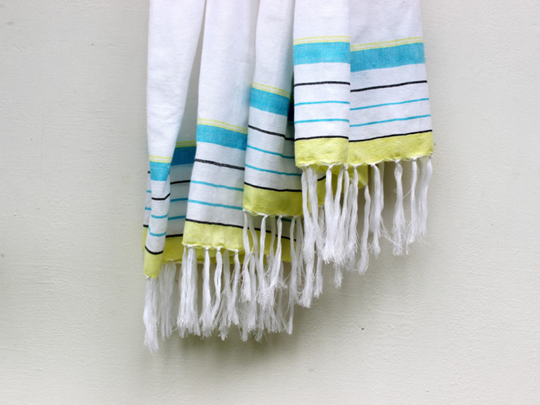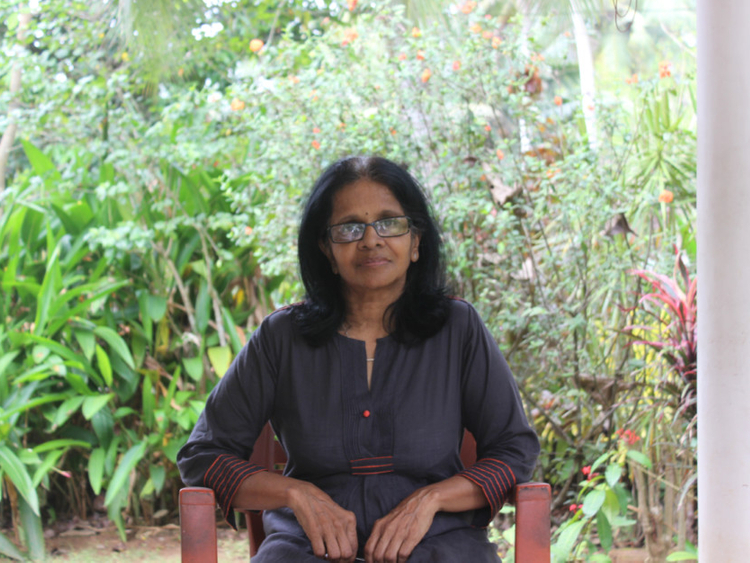
In a tiny hamlet nestled between the bustling cities of Kochi and Kottayam in Kerala’s lush countryside in South India, a quiet revolution is under way as a mother-daughter duo have embarked on the task of preserving and popularising one of the state’s best known but often undervalued symbol of tangible cultural heritage.
It is in a small, sustainably built mud-brick office in Kanjiramattom, her home town, that social anthropologist Indu Menon, 62, is transforming the humble “thorthu”, a twin-strand handwoven fabric and an ubiquitous item in every Kerala household, into a modern, contemporary product by infusing it with a fresh design approach for acceptance among the wider international market.
Primarily used as a towel for drying oneself after a bath, the thorthu is a versatile piece of fabric Keralites have grown up with over the years. Woven by hand in varied lengths and always with a thin strand of colour (“Kara”) marking its borders, the thorthu is the quintessential item — be it in a rich landlord’s manor or in a poor peasant’s home.
Menon’s tryst with the humble thorthu began more than 30 years ago when, as a research associate at the Indian Institute of Management (IIM) Ahmedabad, India, she undertook a joint academic study in 1982 with two of her colleagues on the organisational structure of the handloom cooperatives across India.
Menon focused on Kerala, Tamil Nadu and Andhra Pradesh. She also visited several of the main handloom units operating in these states to gather first-hand experience and knowledge of the work and conditions of the weavers.
In Kerala, the 30-odd looms at Kanjiramattom provided Menon with the backdrop for this project, which metamorphosed into a book, “Women Weavers of South India”. However, 25 years later, post her retirement when she returned home, she was shocked to find that the handloom weavers had quit their profession owing to financial instability.
“Handloom has always been close to my heart and it was painful to see the weaving industry dying,” reminisces Menon. “From the 30-plus units in 1982, the numbers had dwindled down to a mere three in 2005. The onset of the power looms coupled with poor remuneration had forced the weavers to seek alternative jobs while the younger generation too preferred to break away from an industry that could not support their basic needs.”
The weavers have always had a love-hate relationship with their profession, explains Menon. “In Kerala, weaving is a caste-based occupation; and hence, while the passion runs through their blood, it is also regarded as the root cause of their poverty and despair.”
Nowhere is the disparity between the maker and the wearer starker than in the weaving industry, she says. “For instance, the weavers in Kancheepuram and Pochampalli in the states of Tamil Nadu and Telangana who hand-weave coveted six-yard sarees have never been able to afford their own creations.”
In Kerala, too, the story is no different, says Menon, where weavers are paid a mere pittance for their work. “As handloom weaving has historically been received government subsidies, the woven products were highly undervalued by citizens across the state. It lacked the aspirational value a handmade product holds among consumers in other countries. And the onset of power looms unleashed an onslaught of cheaper products further augmenting their woes,” says Menon.
Unused because of lack of demand, the handloom weaving centres soon fell into disrepair. The weaving quality too suffered a setback as experienced weavers began to move on to better paying menial work.
Deeply saddened at the plight of the weavers who were forced to give up a personally fulfilling and gratifying profession to do mundane work just to feed their families, Menon decided it was time to reverse the situation. “I felt I had to do something,” she remembers.
Brainstorming with her daughter, Chitra Gopalakrishnan, a graphic designer in the United States, the mother-daughter team arrived at the idea of modernising the thorthu fabric and marketing it internationally.
“As the thorthu was an everyday use product in Kerala, the fabric has never been fully appreciated by its users. It was seen as old-fashioned, with lacklustre colours and patterns. Hardly anyone gave thought to the fact that being handwoven, it was a highly energy-conservative and eco-friendly fabric as it requires very little water to wash — one-fifth of a fluffy towel; dries quickly and occupies little space.”
She adds, “Even Keralites who have settled in other parts of the world still regularly buy thorthu each time they come home; it has attained a souvenir status. This is a time-tested fabric and I was convinced that with a design makeover and proper marketing, it could be elevated to the status it rightly deserves.”
With support from a couple of other like-minded women, Menon decided to launch a purposeful online business venture that adhered to fair trade practices and where the weavers or artisans would be central to the collaborative process. Thus was born Kara Weaves in the summer of 2008.
The idea was to bridge the gap between the traditional hand weaving art form and a contemporary lifestyle, thereby opening the doors for an opportunity that would enable the weavers to regain their financial stability and pursue their art with passion.
As the first step in tweaking the designs, the team decided to make slight improvisations on the yarn by tightening the weave and ridding the bluish dye from the fabric to enhance its rich, white colour.
Apart from its primary function as a bath towel, the thorthu fabric was also used to create a variety of contemporary items ranging from bath items such as bath robes and beach mats to curtains, hand towels, cocktail napkins, scarves, baby towels, and so on.
Targeting hotels as their initial clients, the first breakthrough for Kara Weaves came about when the Casino Group of Hotels (rebranded as CGH Earth) placed their order for the towel range, convinced of its superiority both in quality and the intrinsic ecofriendly advantages it naturally brings. But it was when a trend forecasting website in the US featured the towel range of products that a flood of inquiry began to flow in.
“Overnight there was a deluge of orders both from individual consumers and brand retailers across the US,” recollects Menon, explaining their successful foray into the US market.
Kara products has since been featured in international publications such as Better Home and Gardens, Martha Stewart Weddings and Lucky Mag, among others, and a host of reputed websites and blogs. To cater to the increasing demand, fabrics are being woven at different units across Kerala including those that are doing well with the profits being rechannelled into reviving the dwindling units.
Fortunately for Menon and her team, the weavers in Kanjiramattom embraced her venture with great enthusiasm. Kara Weaves was a lifesaver for the local cooperative unit, says Mani, a master weaver who has been spinning and weaving thorthu and other fabrics for more than four decades now.
“We were on the verge of closing down; our numbers had dwindled down to just two employees; and our earnings were a fraction of what an average labourer earned,” says Manichettan, as he is fondly known.
The weavers earned a pittance of Rs5 (fils 0.31) per thorthu, which takes around 20 minutes to weave and generally retails at Rs40 in the market. The daily wages were about Rs85. The act of weaving is only about 10 per cent of a complex, labour-intensive pre-looming process, and the wages earned do not fully account for that.
“Often, the only work we received were government supported orders for which we never received payment on time or were paid in the form of raw materials, not cash,” he adds.
“With the arrival of Kara Weaves on the scene, we began to receive advance payment that we utilised as our working capital. And we also earned double the rate provided by the government for our finished products. As the business grew, so did our work. Constant demand and prompt payment is what Kara Weaves had assured us and they’ve kept their word,” he says.
The impact was soon evident as weavers who had earlier quit the profession gradually came back to take up their place behind the loom. At present there are 10 weavers at the Kanjiramattom handloom cooperative unit.
Kara Weaves’s adherence to a fair wage system has seen the weavers receive double the daily wages right from the start. Increased demand and workload has seen their earnings progress to $7 (Dh25.76) per day. “Our target is $10 per day and we will get there soon,” promises Menon.
In the Middle East, Kara Weaves products can be found at The Change Initiative in Dubai and Ecru in Kuwait.
Sangeetha Swaroop is a writer based in Dubai.













